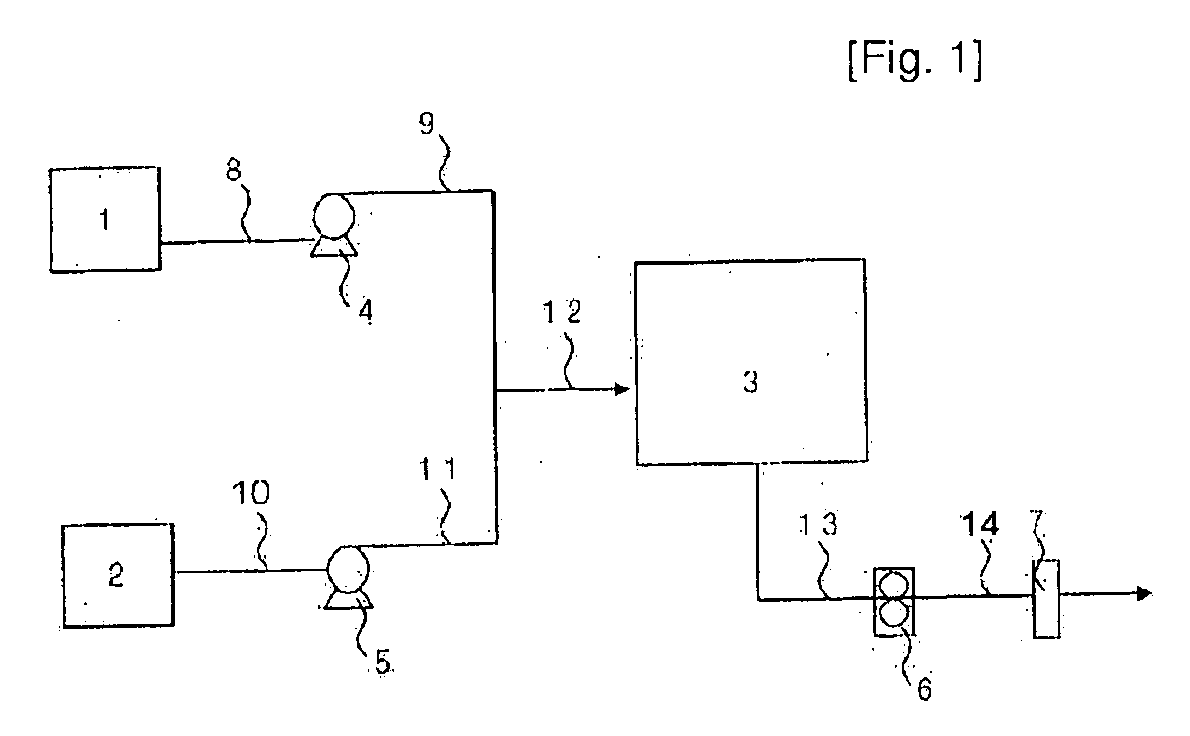Method for Preparing Adhesive Acrylic Ester Polymer Syrup
a technology of acrylic ester and polymer syrup, which is applied in the direction of ester polymer adhesives, adhesive types, etc., can solve the problems of unfavorable productivity and energy saving of batch polymerization, difficult to produce polymer syrups with good capacity, and large energy consumption, so as to achieve very stable polymerization, reduce polymerization time, and increase the degree of polymerization
- Summary
- Abstract
- Description
- Claims
- Application Information
AI Technical Summary
Benefits of technology
Problems solved by technology
Method used
Image
Examples
example 1
[0050] 6 kg of a monomer solution was prepared in the monomer solution reservoir 1 by mixing 96 wt % of 2-ethylhexyl acrylate and 4 wt % of acrylic acid, as a monomer, with 0.08 wt % of pentaerythritol tetrakis(3-mercapto)propionate, as a molecular weight controller. Similarly, 2 kg of an initiator solution was prepared in the initiator solution reservoir 2 by mixing 96 wt % of 2-ethylhexyl acrylate and 4 wt % of acrylic acid, as a monomer, with 0.08 wt % of pentaerythritol tetrakis(3-mercapto)propionate as a molecular weight controller, and 0.0004 wt % of 2,2′-azobis(isobutyronitrile) (AIBN), as an initiator.
[0051] Each of the monomer solution in the monomer solution reservoir 1 and the initiator solution in the initiator solution reservoir 2 was bubbled with nitrogen at 700 mL / min for 30 minutes, respectively, in the monomer solution reservoir 1 and the initiator solution reservoir 2 to maintain the dissolved oxygen in the reservoirs at 0.8 ppm. The temperature of the monomer sol...
example 2
[0055] An acrylic ester polymer syrup was prepared in the same manner as in Example 1, except that 0.00025 wt % of AIBN was used as the initiator, the polymerization temperature was maintained at 100° C., the monomer solution and the initiator solution were supplied at an average rate of 8.7 g / min and 2.1 g / min, respectively, and the mean residence time was maintained at 2.3 hours.
example 3
[0056] An acrylic ester polymer syrup was prepared in the same manner as in Example 1, except that 0.00025 wt % of 1,1-di(t-butylperoxy) 3,3,5-trimethylcyclohexane was used as the initiator, the polymerization temperature was maintained at 125° C., the monomer solution and the initiator solution were supplied at an average rate of 8 g / min and 2 g / min, respectively, and the mean residence time was maintained at 2.5 hours.
PUM
| Property | Measurement | Unit |
|---|---|---|
| Temperature | aaaaa | aaaaa |
| Temperature | aaaaa | aaaaa |
| Fraction | aaaaa | aaaaa |
Abstract
Description
Claims
Application Information
 Login to View More
Login to View More - R&D
- Intellectual Property
- Life Sciences
- Materials
- Tech Scout
- Unparalleled Data Quality
- Higher Quality Content
- 60% Fewer Hallucinations
Browse by: Latest US Patents, China's latest patents, Technical Efficacy Thesaurus, Application Domain, Technology Topic, Popular Technical Reports.
© 2025 PatSnap. All rights reserved.Legal|Privacy policy|Modern Slavery Act Transparency Statement|Sitemap|About US| Contact US: help@patsnap.com


